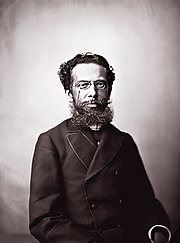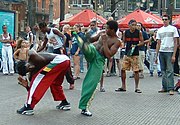Culture of Brazil
From Wikipedia, the free encyclopedia
|
"The Brazilian society and culture are formed as variants of the Portuguese version of the traditional Western European civilization, differentiated by color legacy of Brazilian Indians and black Africans. Brazil emerges thus as a bud mutant, rescheduled from its own characteristics, but tied to the genetic Portuguese matrix, which unsuspected potential to grow and to be full were only realized here" |
| O Povo Brasileiro, Darcy Ribeiro, , pag 16.[1] |


Brazilian culture is a culture of a very diverse nature. An ethnic and cultural mixing occurred in the colonial period between Native Americans, Portuguese and Africans and formed the bulk of Brazilian culture. In the late 19th and early 20th centuries Italian, German, Spanish, Arab and Japanese immigrants settled Brazil and played an important role in its culture, creating a multicultural and multiethnic society. [2]
Contents |
[edit] Major influences
Brazil was a colony of Portugal for over 3 centuries. Large numbers of settlers from Portugal arrived during this period (nearly 1 million [3]) and brought their culture to the colony. The native inhabitants of Brazil had a strong contact with the colonists. Many were exterminated, others mixed with the Portuguese. For that reason, Brazil also holds Amerindian influences in its culture, mainly in its food and language (Brazilian Portuguese has hundreds of words of Native American origin, mainly from the Tupi-Guarani).[4]
Black Africans, who were brought as slaves to Brazil, also participated actively in the formation of Brazilian culture. Although the Portuguese colonists forced their slaves to become "more civilized" (that meant to convert to Catholicism and speak Portuguese) their cultural influences were absorbed by the inhabitants of Brazil of all races and origins. Some regions of Brazil, especially Bahia, have obvious African legacy in the music, food, language, etc.[5]
Immigrants from Italy, Germany, Spain, Japan and the Middle-East played an important role in the areas they settled (mostly Southern and Southeastern Brazil). They organized communities that became important cities (Joinville and Caxias do Sul, for example) and brought important contributions to the culture of Brazil.[6][7]
[edit] Religion

The religion of most Brazilians is Catholicism, in fact, Brazil has the largest Catholic population in the world. Many other beliefs over time have been incorporated into the Brazilian Catholic belief system such as Spiritism, Buddhism, Hinduism, Ayahuasca, and Judaism as well as religious syncretisms, such as Candomblé, Umbanda, and Macumba, that mix Catholicism with African tribal religions. Certain denominations of Christianity, such as Pentecostalism, Methodism, and the Mormon church have also gained a large following.
Carnaval, as it is known in Brazil, is an annual celebration held forty days before Easter and marking the start of Lent. Carnival in Rio de Janeiro is known worldwide for the elaborate parades staged by the city’s major samba schools in the Sambadrome and is one of the world’s major tourist attractions. In other regions such as Bahia and Pernambuco (and throughout Brazil), Carnival takes on a unique regional flavor. Carnival celebrations in Brazil feature locally-originating traditions and music (such as axé and frevo).
[edit] Arts
[edit] Music
Brazil's cultural tradition extends to its music styles which include samba, bossa nova, forró, frevo, pagode and many others. Brazil has also a large contribution to the genres of classical music, which can be seen in the works of composers José Maurício Nunes Garcia (1767-1830), Antonio Carlos Gomes (1836-1896), Elias Álvares Lobo (1834-1901), Alberto Nepomuceno (1864-1920) Heitor Villa-Lobos (1887-1959). Camargo Guarnieri (1907 - 1993), Cláudio Santoro (1919 - 1989), Osvaldo Lacerda (1927) and Eli-Eri Moura (1963), among many others. Some of the most famous Brazilian classical performers are the soprano Bidu Sayão, the pianists Nelson Freire and Guiomar Novaes and the conductors Eleazar de Carvalho and Isaac Karabtchevsky. Brazil is also the land of the São Paulo State Symphony, regarded as one of the outstanding orchestras in Latin America and in the world.
Antônio Carlos Jobim and João Gilberto popularized the Bossa Nova sound, which was followed by Música Popular Brasileira (literally "Brazilian Popular Music", often abbreviated to MPB). In the late 1960s, Tropicalismo was popularized by Caetano Veloso and Gilberto Gil.
Within the last 20 years, Brazil saw a dramatic increase in diversity in the music they express. Ever since 1985 when Brazil became democratic, popular music, such as hip hop became a widely "unprecedented fashion"[8] However, social classes developed between the poor, middle class, and wealthy. Music was influenced by race and equality facts. For example, poor people would talk about how corrupt the government is, the violent and low class life the live in, unequal wealth distribution, and drugs [9] Nevertheless, traditional music, such as samba, managed to keep the country's music scene united as one.
[edit] Literature

Literature in Brazil dates back to the 16th century, to the writings of the first Portuguese explorers in Brazil, such as Pêro Vaz de Caminha, writer of the fleet of navigator Pedro Álvares Cabral. During the colonial period, many writers produced chronicles, poems, and plays detailing the events in the colony. A notable early writer was father António Vieira, a Portuguese Jesuit educated in the Jesuit school of Salvador, Brazil, who became one of the most celebrated Baroque writers of the Portuguese language. The period following the Independence of Brazil in 1822 coincided with the Romantic Period of literature, and the first Brazilian national writers like Gonçalves Dias and José de Alencar gave prominence to the native peoples.
[edit] Cinema
Brazil has a long cinematic tradition, reaching back to the birth of the medium in the late 19th century. In the 1950s, Cinema Novo, (literally "New Cinema") sprang up as a movement concerned with showing realism in film, in the vein of Italian Neorealism and the French New Wave. In recent years, films like Cidade de Deus (2002 - directed by Fernando Meirelles) and Carandiru (2003 - directed by Hector Babenco) gained Brazilian cinema a new level of international acclaim.
[edit] Sport
Sports are very popular in Brazil, the most notable being football(soccer). The Brazilian national soccer team is very popular, both in Brazil and internationally. The Brazilian national team has been victorious in the FIFA World Cup tournament a record five times, in 1958, 1962, 1970, 1994 and 2002. Brazil has produced many of the world's most famous football stars, most notably Pelé, Ronaldo, Ronaldinho and Kaká.
In second but not less popular comes volleyball. The Brazilian national male team has been victorious in the Olympics tournament two times, in 1992 and 2004, two times FIVB world champion in 2002 and 2006 and seven times world league champion. As well, the female team has already won several of the most important competitions, including world championships and the Olympic games.
Brazil is also home to several sports which have become internationally popular, such as capoeira and Brazilian Jiu-Jitsu.
[edit] See also
- History of Brazil
- List of Brazilians
- Painting in Brazil
- Sculpture in Brazil
- Literature of Brazil
- Brazil Skyscrapers
- Tourism in Brazil
[edit] External links
- Brazilian ministry of culture (Portuguese)
- Consulate General of Brazil in San Francisco
- Eyes On Brazil - Brazilian Cultural Site
[edit] References
- ^ Darcy Ribeiro, O Povo Brasileiro, page 16
- ^ BRASIL CULTURA | O site da cultura brasileira
- ^ IBGE teen
- ^ IBGE teen
- ^ IBGE teen
- ^ IBGE teen
- ^ IBGE teen
- ^ Behague, Gerard. "Rap, Reggae, Rock, or Samba/Summer 2006).
- ^ Rohter, Larry. http://www.nytimes.com/2007/03/14/arts/music/14gil.html, March 14, 2007.
|
|||||||
|
||||||||||||||||||||||||||
|
|||||||||||||||||||||||||||||



